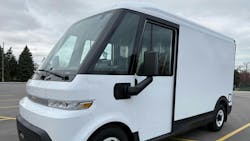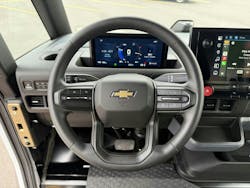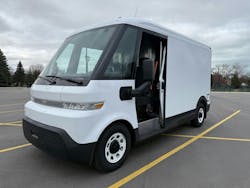How the Chevrolet BrightDrop 400 electrifies delivery operations
The 2025 Chevrolet BrightDrop is a battery-electric cargo van for the last-mile delivery segment, and soon, drivers might start seeing these vehicles on the road, as they are now available for public purchase
I received the Chevrolet BrightDrop 400 and drove it around for a full week. Here are my impressions:
How BrightDrop compares on power
The BrightDrop 400 offers a 153" wheelbase and 400 cu. ft. of cargo space, and a maximum payload of 3,710 lb. The difference between the BrightDrop 400 and the nearly identical BrightDrop 600 is that the 600 is a bit longer, with a wheelbase of 183", offering 600 cu. ft. of cargo space and a 3,350-lb. max payload.
Chevrolet claims the van can reach 272 combined city and highway miles on all-wheel drive models equipped with the manufacturer’s “Max Range” battery, which I reviewed. But the BrightDrop can also come with a standard battery, which the company says has an estimated range of 193 city miles and 151 highway miles.
What are BrightDrop’s safety and tech features?
The BrightDrop is designed for work, which it showcases with its driver assistance safety technology and a few BrightDrop-specific tech perks. But with all of that, the vehicle still feels very much like a commercial rig.
In my opinion, the most significant tech to talk about with this van is those that were BrightDrop exclusive.
How BrightDrop prioritizes safety with its tech
The BrightDrop is equipped with driver assistance and safety features, and all of those features—more than 20—are standard.
These include automatic emergency braking, automatic pedestrian and cyclist braking, forward collision alert, front and rear park assist, lane keep alert and assist, automatic high beam headlights, and more. The forward collision alert and the lane keeping alert also include driver’s seat vibrations.
The BrightDrop also has multiple cameras to assist the driver, including blind spot cameras that activate with the turn signals and a 360-degree view camera. All camera views are displayed on the 11.3" infotainment screen. While the blind spot camera views are helpful, it is worth noting that their quality could be improved.
Another safety feature is the automatic task lighting that illuminates on the back of the vehicle if it detects motion with the key fob nearby.
Infotainment system breakdown
The BrightDrop features an infotainment system with built-in Google support, giving the operator access to Google Maps and other Google apps. Upon entering the vehicle, I signed into my Google account on the infotainment screen and found all my favorite and most-visited addresses in the Google Maps app.
The BrightDrop also features wireless Apple CarPlay and Android Auto—a requirement for my own personal tastes. While I never had connectivity issues with Apple CarPlay or my phone in the BrightDrop, my one gripe with the system was that when using the Google Maps app within Apple CarPlay, the map only showed a compass view of my navigation. To get a directional view of my navigation, I had to move from Apple CarPlay’s Google Maps to BrightDrop’s built-in Google Maps app.
How did the Chevrolet BrightDrop drive?
Typically, I always enjoy driving cargo vans because of their ride height, which automatically increases visibility. But GM, along with other OEMs, are optimizing visibility in other ways, too, such as through the Bright Drop's large windows, large mirrors, a 360-degree camera, and blind spot/side view cameras that automatically deploy when the turn signal is activated. The BrightDrop also has an extremely large windshield, which is what I believe is the most attention-grabbing feature of the van’s exterior.
Visibility wasn’t much of an issue for me while driving the BrightDrop, but it’s worth noting that there is no rearview mirror in this van—not even one that’s essentially a rear-view camera monitor. When I asked about it, the company noted that there's wasn't many places to put such a monitor or mirror. The windshield feels like it's about 5' from the driver's seat, and any rear-view mirror or camera monitor would need to be large to benefit any driver.
There were times when I absolutely enjoyed driving the BrightDrop. I appreciated its low step height, visibility, and one-pedal driving. But there were also times when it was a bit frustrating. For instance, it rained on the day we drove north, and there was an obvious leak in the cabin area. It wasn’t significant, and it didn’t appear to be near anything that would cause a problem. While it seemed to have resolved itself by the next day when it rained even harder, a leak is something you never want to see in a new vehicle.
Overall impressions of the Chevrolet BrightDrop
The BrightDrop is a distinctive cargo van with an eye-catching exterior and a futuristic feel. Its flat side panels also offer a blank slate for businesses’ rolling advertisements.
The fact that it produces zero tailpipe emissions and will require less maintenance automatically make it tempting, too. Still, the price point might cause it to take some significant use time before you see any economic advantage (the exact model I drove comes with nearly a $92,000 price tag).
Further, while I have yet to drive the Ford E-Transit and have only driven the Ram Promaster EV a short distance, the inerior appointments between traditional cargo vans and the BrightDrop were significant.
The interiors of both the Ram ProMaster EV and the Ford E-Transit are similar to both brands’ passenger vehicle offerings and even more like the ICE versions of these vans. However, the Brightdrop is very clearly designed as a commercial vehicle, leaving out those similar dashboards, traditional cup holder spaces, and even glove compartment storage areas. Instead, storage and cup holders are moved elsewhere, wiring under the dash is clearly exposed, and simply operating doors (in certain packages) requires the operator to re-learn a few behaviors that might once have been second nature.
These aren't cons of the BrightDrop, but perhaps simply features that will take time for drivers to get used to. Once they do, the BrightDrop can potentially increase last-mile delivery driver efficiency—while producing zero tailpipe emissions.
This article originally appeared on FleetOwner.com.
About the Author

Jade Brasher
Senior Editor Jade Brasher has covered vocational trucking and fleets for the past five years. A graduate of The University of Alabama with a degree in journalism, Jade enjoys telling stories about the people behind the wheel and the intricate processes of the ever-evolving trucking industry.




